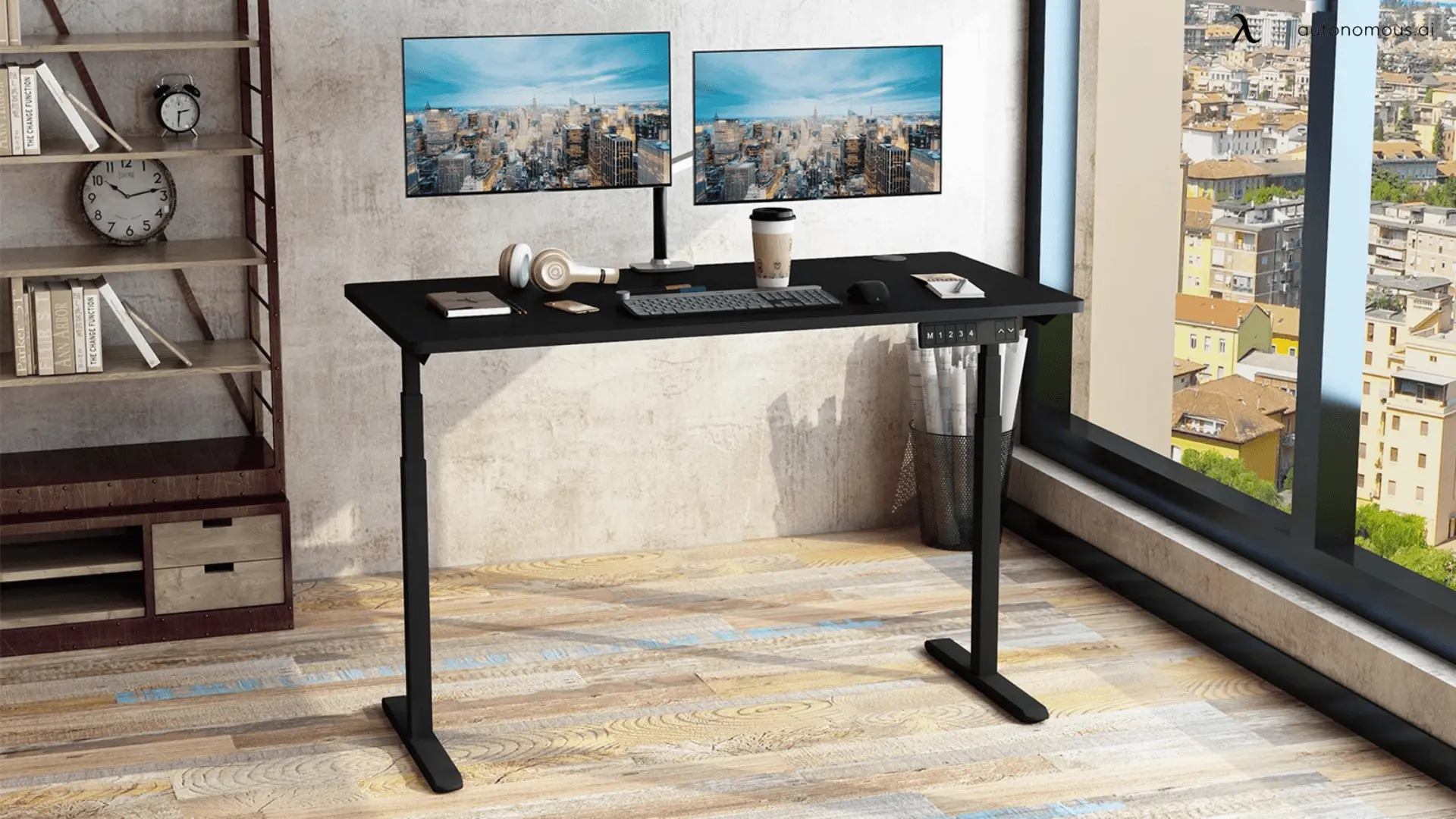
Table of Contents
How do standing desks feel? To be honest, standing desks can feel exhausting at first. Transitioning from sitting all day to standing while working can be challenging, and most people find they need to sit down after just a few minutes when they first start. Much like using a treadmill for the first time, standing at a desk requires an adjustment period, but over time, users begin to notice the health benefits and improved comfort.
So, are standing desks healthy? The short answer is yes. A standing desk can help boost productivity, improve mood, and enhance mental agility. Many users report that standing helps them stay more engaged with colleagues and customers while also improving memory retention. However, the transition period can be difficult, and users should ease into it by alternating between sitting and standing until they build endurance.
If you're considering a standing desk, there are plenty of options based on different needs and preferences. A gaming standing desk is ideal for those who want an ergonomic setup for long hours of play. If you need more workspace, an L-shaped standing desk offers extra surface area. For those who prefer customization, a DIY standing desk or standing desk legs allows users to create a personalized setup.
Specialized designs also cater to different needs. A 4-leg standing desk provides enhanced stability, while a non-electric standing desk is a great choice for those who prefer a manual adjustment system. A 2-tier standing desk offers additional organization and ergonomic benefits, and a tall standing desk ensures proper height for taller individuals.
Understanding the challenges and benefits of standing desks can help make the transition smoother. By choosing the right model and gradually incorporating standing into your routine, you can maximize the health benefits while maintaining productivity and comfort throughout the workday.
3 Common Problems with Standing Desks
1. Uncomfortable to start
As we mentioned earlier, a standing desk takes some time to get used to. Over time, your weight will shift from foot to foot, move your feet about, and feel like taking a break. People may lean on the work surface. You may desire/need to sit within minutes, but usually within an hour, your standing desk height should be adjustable to change your standing position.
You put more stress on your heart when you stand than when you walk since you do not use your muscles to circulate your blood. The level of tension on your legs while sitting is lower than the level required to maintain your balance when you are standing.
It is important to take breaks and move around whether you are sitting or standing. If you don't prepare, you'll be in for a brutal first few days/weeks. Getting used to standing for that long will take different people a different amount of time. Initially, it may seem uncomfortable, but if you stick with it, it will pay off.
The other disadvantage is that you are visible to everyone when you are standing at your adjustable standing desk for the home office. So yes, this part also has its disadvantages. It only applies if you're in an open workspace (which has become more common). You don't need it as much if you work from home.
2. Health Risk
There is a debate over whether are standing desks bad? Standing up is indeed more calorie-dense than sitting. When standing, the body is forced to recruit more muscles to maintain proper posture. When employees use a standing desk, they become tired faster because of the increased calorie expenditure.
It is particularly tiring for the feet and legs to remain standing for several hours at a time since they have to carry constant weight. Those who are not used to standing for prolonged periods suffer fatigue even more.
For blood to return to the heart, it needs to travel up the legs. The problem is that standing forces fluids to flow against gravity, making it difficult for them to return to the rest of the body.
In order to keep fluid from building up in the lower extremities, the human body has valves that prevent backflow into veins. These features, however, can wear out over time, particularly when the person stands for prolonged periods.
Standing for long periods can lead to leg pain for two reasons. Keeping the legs steady and balanced requires the foot and leg muscles to work overtime. As these muscles become fatigued, they may feel uncomfortable. This can occur after a long day at a standing desk.
When a person stands still, their feet are constantly under pressure. The fat pads protect overexertion of the muscles and joints under the heels. However, the fat pads are insufficient to protect the feet from prolonged standing. Standing still causes the undersides of your feet to become compressed. When the tissues are compressed, the blood circulation is reduced, resulting in pain and discomfort.
3. Limited Seating Options
One of the challenges with standing desks is the limited compatibility with traditional seating options. Since standing desks are designed to be used at adjustable heights, users typically switch between standing and sitting rather than reclining or lying down. This means that certain furniture, like beds or low desks, may no longer be practical for working. Additionally, many people find that their existing office chairs are not compatible with their new standing desk, requiring an upgrade to a more suitable seating option.
For those using dual monitors, ensuring the right standing desk dual monitor setup is crucial for maintaining an ergonomic workstation. If you need a new chair that works well with an adjustable-height desk, exploring ergonomic chairs can help improve comfort. Those with back pain may benefit from an ergonomic chair for lower back pain or a reclining ergonomic chair for better posture support.
For added flexibility, an ergonomic chair with a leg rest can provide extra comfort when switching between sitting and standing. Those who prefer active seating may find an ergonomic stool for a standing desk to be a practical alternative. If size and weight capacity are concerns, consider options like an office chair for petite women or an office chair 300 lbs for added durability.
While standing desks may require adjustments to your current setup, investing in the right ergonomic seating solutions ensures a comfortable and supportive work environment.
FAQs
What are the risks of standing at a desk all day?
Standing at your desk for the entire day might not be a good idea. Standing too much also damages your health. Excessive sitting deteriorates your health, as does excessive sitting. Numerous studies show that standing is associated with serious health problems, such as low back and leg pain, heart disease, fatigue, and other discomforts.
Why can't I raise my standing desk?
Something mounted above your desk may be stopping it from moving upward. These could be shelves, cabinets, or artwork mounted above your desk. The desk may have been temporarily unplugged and plugged back in, or the outlet might have lost power.
It is common for standing desks to reset themselves when they lose and regain power automatically. Sit-stand desks can only move downward while in reset mode. Depending on how much use your standing desk gets, the legs can become uneven over time.
The motor and spindle can turn without a good self-locking mechanism if the motors don't have one. The second motor remains still or turns more/less than the first motor, depending on the first motor's speed.
What health benefits do standing desks provide?
Standing desks have been shown to decrease stress and fatigue, improve mood, and increase energy levels. Whether you're sitting or standing, standing burns more calories, and research shows that standing and moving more during the day can improve your health.
Conclusion
Standing desks offer several benefits, but they also come with challenges that users should be aware of. Initial discomfort is common as the body adjusts to prolonged standing, and without proper posture and movement, standing desks can contribute to health risks like joint strain or circulation issues. Additionally, finding the right seating options for breaks can be a challenge, as not all chairs are designed for height-adjustable desks.
To maximize the benefits of a standing desk, proper usage and ergonomic adjustments are essential. Learning how to use a standing desk effectively can help improve posture and reduce strain. If adjusting your desk height is a struggle, consider upgrading with a standing desk motor kit for smoother transitions. For those needing additional space or flexibility, a standing desk extension can enhance your workstation setup.
While standing desks are not inherently bad, their effectiveness depends on proper setup, movement, and balancing sitting and standing. By incorporating anti-fatigue mats, ergonomic stools, and frequent posture changes, you can create a comfortable and dynamic workspace that supports long-term health and productivity.
Stay connected with us!
Subscribe to our weekly updates to stay in the loop about our latest innovations and community news!
Interested in a Link Placement?
Spread the word
.svg)
.svg)



/https://storage.googleapis.com/s3-autonomous-upgrade-3/production/ecm/230914/bulk-order-sep-2023-720x1200-CTA-min.jpg)

/https://storage.googleapis.com/s3-autonomous-upgrade-3/production/ecm/230824/image_qIN1zTxi_1692157652807_raw-c3a7f648-6021-42f1-a20f-0874805faad0.jpg)